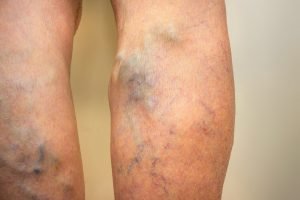Symptoms
Vein Symptom Guide
Vein Overview
More than 80 million people in the United States have problems with their veins, the vessels that return blood to the heart once it has circulated through the body. Many people suffering from venous disorders come to vascular surgeons looking for treatment to either relieve pain or improve the visible appearance due to diseased veins.
Veins have one-way valves that help keep blood flowing in the proper direction. If these valves stop functioning the way they are supposed to, blood can flow backwards and pool in the vein branches, causing them to stretch and become varicose veins. This condition is known as venous insufficiency.
These enlarged blood vessels fall into two groups: spider veins and varicose veins. Spider veins are visible on the surface of the skin as red, blue or purple lines. Varicose veins are larger and deeper and often look like bluish bumps under the skin.
Swelling of Foot, Leg, and/or Ankle

Foot, leg, and ankle swelling is also known as edema, which refers to an accumulation of fluid in this part of the body. The most common cause of ankle swelling is due to some degree of venous (circulation) or lymphatic damage.
How we diagnose:
- Initial Consultation
- Assessment
- Ultrasound
- Treatment Plan
How we treat?
- Endovenous Laser Therapy (EVLT)
- Radiofrequency Ablation (ClosureFast)
- Compounded Sclerotherapy
- Micro-foam Sclerotherapy
- Non thermal Ablation (Venaseal)
Leg Pain and Aching
People often get leg pain and aching due to circulation problems caused by blood clots, varicose veins or poor circulation.
How we diagnose:
- Initial Consultation
- Assessment
- Ultrasound
- Treatment Plan
How we treat:
- Endovenous Laser Therapy (EVLT)
- Radiofrequency Ablation (ClosureFast)
- Compounded Sclerotherapy
- Micro-foam Sclerotherapy
- Non thermal Ablation (Venaseal)
Leg Heaviness or Fatigue
Leg heaviness, or a sensation of aching fatigue in the legs, can be due to multiple cause including muscular disorders, joint issues, and circulatory disorders. A very common cause is venous insufficiency, or vein disease.
How we diagnose:
- Initial Consultation
- Assessment
- Ultrasound
- Treatment Plan
How we treat:
- Endovenous Laser Therapy (EVLT)
- Radiofrequency Ablation (ClosureFast)
- Compounded Sclerotherapy
- Micro-foam Sclerotherapy
- Non thermal Ablation (Venaseal)
Leg Cramps
Cramping is often thought to be caused by deficiency of potassium or dehydration, while true this is not the most common cause. Most people who have reoccurring day or night leg cramps have a circulation problem.
How we diagnose:
- Initial Consultation
- Assessment
- Ultrasound
- Treatment Plan
How we treat:
- Endovenous Laser Therapy (EVLT)
- Radiofrequency Ablation (ClosureFast)
- Compounded Sclerotherapy
- Micro-foam Sclerotherapy
- Non thermal Ablation (Venaseal)
Restless Legs
- Initial Consultation
- Assessment
- Ultrasound
- Treatment Plan
- Endovenous Laser Therapy (EVLT)
- Radiofrequency Ablation (ClosureFast)
- Compounded Sclerotherapy
- Micro-foam Sclerotherapy
- Non thermal Ablation (Venaseal)
Burning or Itching Skin
- Initial Consultation
- Assessment
- Ultrasound
- Treatment Plan
- Endovenous Laser Therapy (EVLT)
- Radiofrequency Ablation (ClosureFast)
- Compounded Sclerotherapy
- Micro-foam Sclerotherapy
- Non thermal Ablation (Venaseal)
Varicose Veins
Varicose veins are tortuous, enlarged veins. Any superficial vein may become varicosed, but the veins most commonly affected are those in your legs. Varicose veins are caused when there is high pressure in leg veins.

How we diagnose:
- Initial Consultation
- Assessment
- Ultrasound
- Treatment Plan
How we treat:
- Endovenous Laser Therapy (EVLT)
- Compounded Sclerotherapy
- Micro-foam Sclerotherapy
